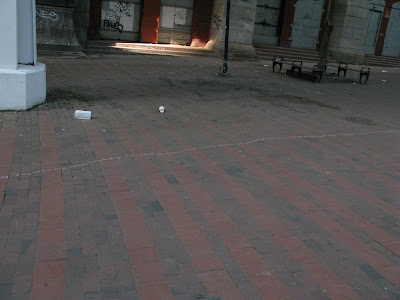After an initial meeting in July 2010, Jean-Christophe Norman and myself have decided to clarify our written exchange. The artist explained to me and what is its practice, its genesis to its development, and I respond, questions, day after day. Until ...?
Lapalu Sophie: When I say you want the viewer to distance, it is precisely why you refuse the spectacular, because the viewer is a condition of spectacular. Why you not only inviting people to attend your steps? I realize that this would be absurd, but it is a hypothesis to raise the fact that you act "in secret" in a certain way. Moreover, if we believe you, it is difficult to detect the artistic character of your gesture. Is it in order to be more effective to reach the real surprise and "doing well up the ambiguity of [the] meaning [of your gesture]" (Patrice Loubier)?
Jean-Christophe Norman: I happened to make a long walk to the Museum of Contemporary Art of Epinal. I was asked to conduct a performance as part of the exhibition In the abyss of time (FRAC Lorraine). The public had been informed but nothing distinguished me from the visitors. So as to "assist" in this performance he had himself to remain very long in the museum and stretch the time of the visit for me to discern. Perhaps we should see this gesture as an incentive to behave differently in the museum.
This year, in the context of the Biennale of Poznan, j 'I realized performance ( poznan Crossing - the circumstances of the accident ) In which I crossed the city in writing the passage of time on the ground with chalk white: this is materialized in a long white line that went from the airport to Warsawstreet. It lasted more than ten days and the inhabitants of Poznan have seized much of this action. They invented stories and the fact that the line was cleared by the almost daily rain hit much. Most saw it as a poetic effect. Me, I make nothing, but this perception affects me, largely because it escapes me, because it is not specifically intended or targeted. Things may appear more clearly in this sort of this unfolded. The moments on-live are not covered with a filter, they may appear in an ambiguity of meaning, but I think it is this ambiguity that makes them brighter, more promising sensations. This is basically what determines the choice of images that I remember and probably that I "fabricated". I do not envisage only as photographs or documents. I hope they convey a certain energy or "atmosphere". I do not want them to be an illustration.
SL: There would then lived event and its second hearing. What is fundamental to raise is that the viewer is not passive, you implied in your work because it completes the picture. I found an echo of what you say in the analysis of Roland Barthes about an exhibition of photographs gathered to shock: "None of these photographs, too clever, reaches us." Indeed, he explains: "It's that face them, whenever we are dispossessed of our decision: we simmered for us, we thought for us, it was held for us, the photographer does is nothing left "(" Shock-Photos, "Mythologies .) You, you do exactly the opposite.
JC. N: Well cases, I try hard. I am very sensitive to these words of Roland Barthes, I think, also speaks of the need for invention of a home in the viewer and you'll notice that one can often mean the same thing in the film and any form writing that seeks to maintain close ties with the film, for reasons that can be imagined. Often the film puts us in a passive attitude. But when I say I am sensitive to the images that the viewer must complete this does not mean it is incomplete images. In their design, which includes action to which they relate, and provided they are thinking in a spirit of openness and / or distance, I believe that images can be "complete" and stimulate the imagination. Vincent Kaufmann wrote that, from beginning to end, Guy Debord has continued to publish works that he wanted to be complete. Without doubt, due to the movement they make, conitnuent they question us. So it is perhaps not the plasticity of images that create or annihilate the dialogue, but the attitude they convey, or a situation in which they do.
In a series of work, I copy the classic texts of literature. These writings often belong to register or epic novel of initiation. The books are entirely copied by hand onto a large format. The vision of the book is so front. The book is presented as a mass of text. As Klaus Speidel wrote, "these manuscripts do not require a viewer who gazes motionless, but a visitor who moves physically active and mentally in front of the text." For me, all these experiments are linked together, I can make separation between my performance and these parts. Most of the time he comes to do something from one point to another, and to provide vision.



0 comments:
Post a Comment